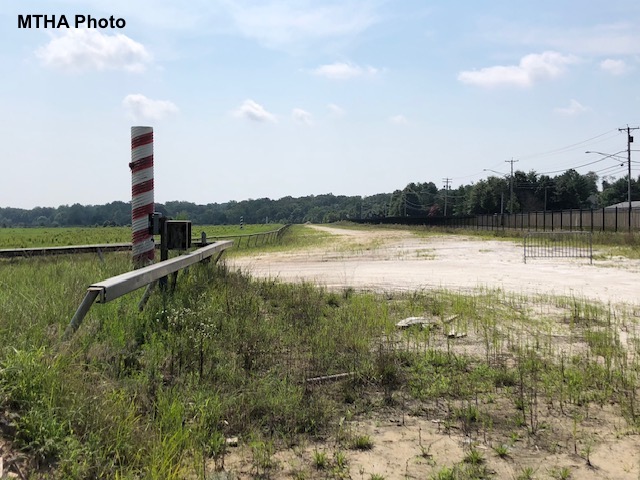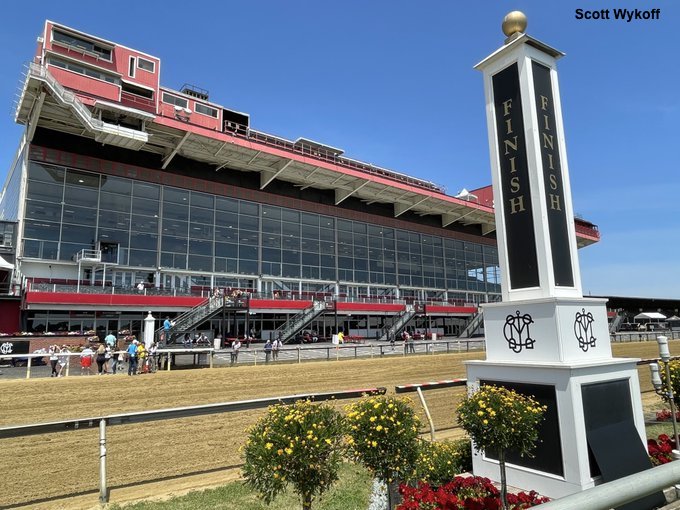
The former Bowie Training Center. (MTHA Photo)
MTROA provides update on MD racing redevelopment plan
MTHA News Release
BALTIMORE, Md.—The Stronach Group (1/ST Racing), in a Sept. 29 presentation before the Maryland Thoroughbred Racetrack Operating Authority, offered its vision for the future of racing in the state: a rebuilt Pimlico Race Course; a “state-of-the-art” training center at a yet-to-be determined location; equine safety protocols that exceed those the company has in California; a condensed calendar that would greatly reduce dates; and a redistribution of the share of video lottery terminal revenue that goes to purses in Maryland.
The meeting was one of several planned as the MTROA, created this spring by the state General Assembly, prepares to submit a report to lawmakers by Dec. 1 of this year. The Maryland Thoroughbred Horsemen’s Association, which advocates for year-round continuity for any redevelopment plan, will make its presentation at the Oct. 8 meeting of the authority.
Craig Fravel, Chief Executive Officer of 1/ST Racing, said the Preakness Stakes is a “critical and valuable component” of any redevelopment plan, as is a new Pimlico. “Day-to-day” racing must be “reimagined” to make it economically sustainable, said Fravel, who floated a schedule 80 or 90 days a year rather than the about 150 currently offered at Laurel Park and Pimlico to maximize daily average purses.
Fravel, who is based in California, also suggested a realignment of Mid-Atlantic racing dates and coordination by racetracks. He said there were discussions with horsemen about suspending live racing in Maryland during part or all of the Colonial Downs summer meet, and also suggested that winter racing is not ideal.
“There are conversations we need to have and figure out what the calendar will look like,” Fravel said. “The calendar must adapt to the horse population. Pimlico is perfectly sized for a ship-in race meet with a certain number of days.”
1/ST officials offered no specifics on a year-round training center, which is currently being studied by the MTROA and its consultants. Fravel did say it costs $7 million to $8 million a year to operate a training center; that the company is willing to do a “transition operation” at Laurel while Pimlico is under construction; and if the shuttered Bowie Training Center, which it still owns, is identified as the best option, the company would be willing to have discussions with the MTROA and the city to see if local government would support a training center on the 200-plus acre property.
At an earlier MTROA meeting, architects noted that a redesigned Pimlico could accommodate no more than 350 stalls. The MTHA and others believe another facility that can house about 1,200 horses is necessary to ensure the future of the Maryland racing and breeding industry.
According to financial information provided to the MTROA, the Maryland Jockey Club in 2022 generated $36.5 million in revenue (excluding Preakness day and its Standardbred meets at Rosecroft Raceway) and had expenses of $46.5 million. Preakness day, which in 2016 produced a profit of $8.9 million, lost close to $2 million in 2022, according to the financial information.
The Maryland Purse Dedication Account receives 6% of gross VLT revenue from the state’s six casinos, with 80% set aside for Thoroughbred racing. Another 1% goes to the Racetrack Facilities Renewal Account for capital improvements, but Fravel said an issue is that no money goes to the racetracks from alternative gaming for operations unlike New York, Virginia and Kentucky.
The MTHA and Maryland Horse Breeders Association have noted that as part of their 10-year agreement with the MJC, they have contributed more than $90 million to the company to support operations and additional racing dates. The next deadline for an extension of the live racing agreement with the MJC is Dec. 31, 2023.
“It is a massively expensive day-to-day operation,” Fravel said. “Day-to-day racing must be reimagined to make it economically sustainable. We’ve been in some form of transition in Maryland for the past eight years and we still find ourselves looking for a viable solution.”
The MTROA was created in part to move along the stalled racing redevelopment plan outlined in 2020 legislation, but it also was granted the power to actually oversee racing operations if necessary.
MTROA provides update on MD racing redevelopment plan

The Maryland Thoroughbred Racetrack Operating Authority Sept. 20 provided an update on the redevelopment plan for Pimlico Race Course and Laurel Park during a webinar hosted by the Maryland Thoroughbred Horsemen’s Association for its members.
The MTROA was created via legislation approved by the Maryland General Assembly earlier this year. The authority is working with the Maryland Stadium Authority and Maryland Economic Development Corp. on the redevelopment plan, which was authorized by state lawmakers in 2020.
The original plan called for reconstruction of both tracks for $375 million derived from a share of casino video lottery terminal revenue dedicated to the racing industry and bonds. Reports prepared last year for the General Assembly indicated the initial estimate was far below the amount required to rebuild both facilities.
The MTROA is required to report back to the General Assembly by Dec. 1 on the status of the plan. MTROA Chairman Greg Cross during the webinar said the authority is focused on Pimlico being the lone major track in the state; identifying locations for a training center given the fact a rebuilt Pimlico could only house about 350 horses; and reviewing other “operational models” that would best suit Maryland racing.
Pimlico and Laurel are owned by 1/ST Racing (The Stronach Group). Officials during the meeting indicated there are still no signed agreements from TSG to turn over the Pimlico property to the city of Baltimore as was mandated in the 2020 law, and that they still have not received word from TSG on the absolute value of the Laurel property.
Though Laurel will remain open for racing and training for years to come, MTROA and MSA officials indicated the property is problematic for redevelopment given environmental issues, easements, and the probable need to completely replace all infrastructure. Alan Foreman, general counsel for the MTHA and a member of the MTROA, said multiple sites are being considered for a new training center, including the old Bowie Training Center, the Maryland State Fair at Timonium, the Fair Hill property, and the Naval Academy Dairy Farm property in Gambrills in Anne Arundel County.
Should the project move forward quickly, the earliest demolition could begin at Pimlico is after the 2024 Preakness Stakes meet. Officials said the redevelopment of Pimlico would likely take four years start-to-finish.
Foreman said negotiations with TSG have not yet begun on a new 10-year agreement, which earlier this year was extended through Dec. 31, 2023. He said with creation of the MTROA, which if necessary would oversee racing operations, “we can feel good about the continuation of racing beyond” Jan. 1, 2024.
The MTROA announced it has two upcoming public meetings: Sept. 29, when it will hear from TSG officials, and Oct. 8, when the MTHA will make a presentation. The meetings thus far have been held at the MSA office in Baltimore and are available to view live online.
The following reports are available:
Interim report on future funding models for Maryland racing
Laurel Park feasibility report
Maryland Stadium Authority report on redevelopment plan
Maryland Stadium Authority presentation to Maryland Thoroughbred Racetrack Operating Authority


